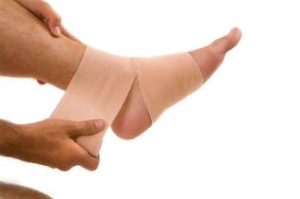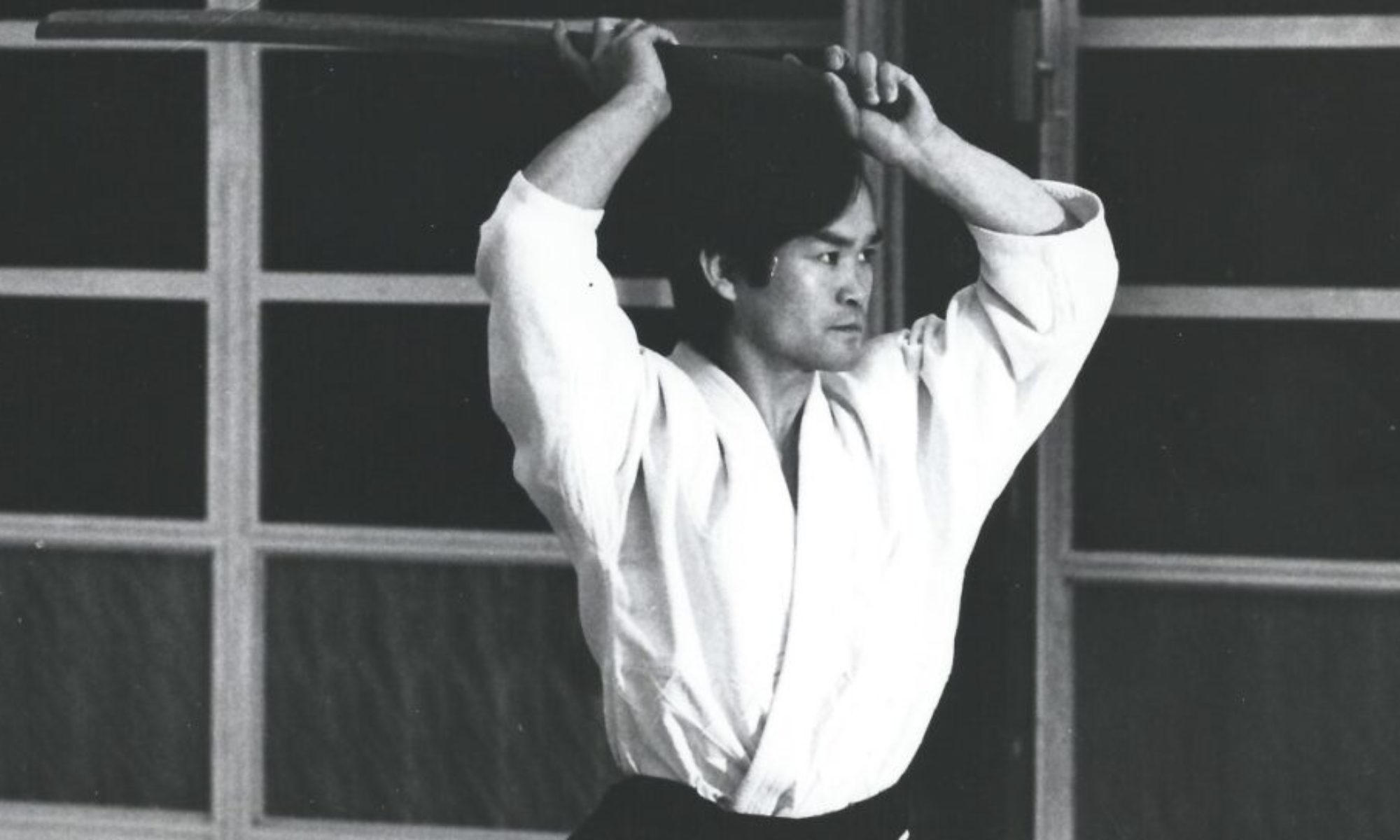By Mike Doren
With introduction by Suzane Van Amburgh, Multnomah Aikikai
Have you ever incurred a strain or sprain? What’s the difference really and what can one do about it?
 During an intensive training session we sometimes push a little harder, reach a little farther and an injury can occur.
During an intensive training session we sometimes push a little harder, reach a little farther and an injury can occur.
After a period of intensive training (such as Aikido summer camp), there is also a risk of suffering an injury as you return to your regular training schedule. Even regular daily activities can trigger an injury after a period of intensive training. People often report that they were “doing nothing” at the time they incurred the injury. After further inquiry it is revealed that the person recently engaged in intensive physical activity or an unusual use of self (eg. we moved last weekend or I went white water rafting for the first time).
Whether you have an injury now or you recently trained intensively, I encourage you to read this excellent article below by my colleague Mike Doren.
Along with being a Guild Certified Feldenkrais® Practitioner, Mike’s background in construction, mechanics, bodybuilding, martial arts, and professional marksmanship provides a deep knowledge base to draw from, regarding the physical/mechanical aspects of the work. Learn more about Mike Doren at: http://www.feldenkraisinstitutenw.com/Michael_E_Doren.html
posted by Suzane Van Amburgh, GCFP, 5th dan, shidoin, Multnomah Aikikai
Sprains and Strains
By Mike Doren
Sprains are injuries that affect ligaments. They occur in response to a stretch or tear of a ligament. Sprains are an acute type of injury that results from trauma such as a fall or outside force that displaces the surrounding joint from its normal alignment. Sprains can range from a mild ligament stretch to a complete tear. Bruising, swelling, instability, and painful movement are common symptoms experienced after a sprain occurs.
Sprains occur most often in the ankles, knees or the arches of the feet. Sprained ligaments swell rapidly and are painful. Generally, the greater the pain is, the more severe the injury is. For most minor sprains, you can probably treat the injury yourself. If you heard a popping sound at the time of the injury, have a fever or aren’t improving within a couple of days, seek medical treatment because inadequate or delayed treatment may cause long-term joint instability or chronic pain.
Strains are injuries that affect muscles or tendons. They occur in response to a quick tear, twist, or pull of the muscle. Strains are an acute type of injury that results from overstretching or over contraction. Pain, weakness, and muscle spasms are common symptoms experienced after a strain occurs.
What Causes a Sprain?
A sprain can result from a fall, a sudden twist, or a blow to the body that forces a joint out of its normal position and stretches or tears the ligament supporting that joint. Typically, sprains occur when people fall and land on an outstretched arm, slide into a baseball base, land on the side of their foot, or twist a knee with the foot planted firmly on the ground.
Where Do Sprains Usually Occur?
Although sprains can occur in both the upper and lower parts of the body, the most common site is the ankle. More than 25,000 individuals sprain an ankle each day in the United States.
The ankle joint is supported by several lateral (outside) ligaments and medial (inside) ligaments. Most ankle sprains happen when the foot turns inward as a person runs, turns, falls, or lands on the ankle after a jump. This type of sprain is called an inversion injury. The knee is another common site for a sprain. A blow to the knee or a fall is often the cause; sudden twisting can also result in a sprain.
Sprains frequently occur at the wrist, typically when people fall and land on an outstretched hand. A sprain to the thumb is common in skiing and other sports. This injury often occurs when a ligament near the base of the thumb (the ulnar collateral ligament of the metacarpo-phalangeal joint) is torn.
What Are the Signs and Symptoms of a Sprain?
The usual signs and symptoms include pain, swelling, bruising, instability, and loss of the ability to move and use the joint (called functional ability). However, these signs and symptoms can vary in intensity, depending on the severity of the sprain. Sometimes people feel a pop or tear when the injury happens.
A grade I or mild sprain is caused by overstretching or slight tearing of the ligaments with no joint instability. A person with a mild sprain usually experiences minimal pain, swelling, and little or no loss of functional ability. Bruising is absent or slight, and the person is usually able to put weight on the affected joint.
A grade II or moderate sprain is caused by further, but still incomplete, tearing of the ligament and is characterized by bruising, moderate pain, and swelling. A person with a moderate sprain usually has more difficulty putting weight on the affected joint and experiences some loss of function. An x ray may be needed to help the health care provider determine if a fracture is causing the pain and swelling. Magnetic resonance imaging is occasionally used to help differentiate between a significant partial injury and a complete tear in a ligament, or can be recommended to rule out other injuries.
People who sustain a grade III or severe sprain completely tear or rupture a ligament. Pain, swelling, and bruising are usually severe, and the patient is unable to put weight on the joint. An x ray is usually taken to rule out a broken bone. When diagnosing any sprain, the provider will ask the patient to explain how the injury happened. He or she will examine the affected area and check its stability and its ability to move and bear weight.
When to See a Doctor for a Sprain
•You have severe pain and cannot put any weight on the injured joint.
•The injured area looks crooked or has lumps and bumps (other than swelling) that you do not see on the uninjured joint.
•You cannot move the injured joint.
•You cannot walk more than four steps without significant pain.
•Your limb buckles or gives way when you try to use the joint.
•You have numbness in any part of the injured area.
•You see redness or red streaks spreading out from the injury.
•You injure an area that has been injured several times before.
•You have pain, swelling, or redness over a bony part of your foot.
•You are in doubt about the seriousness of the injury or how to care for it.
What Causes a Strain?
A strain is caused by twisting or pulling a muscle or tendon. Strains can be acute or chronic. An acute strain is associated with a recent trauma or injury; it also can occur after improperly lifting heavy objects or overstressing the muscles. Chronic strains are usually the result of overuse: prolonged, repetitive movement of the muscles and tendons.
Where Do Strains Usually Occur?
Two common sites for a strain are the back and the hamstring muscle (located in the back of the thigh). Contact sports such as soccer, football, hockey, boxing, and wrestling put people at risk for strains. Gymnastics, tennis, rowing, golf, and other sports that require extensive gripping can increase the risk of hand and forearm strains. Elbow strains sometimes occur in people who participate in racquet sports, throwing, and contact sports.
What Are the Signs and Symptoms of a Strain?
Typically, people with a strain experience pain, limited motion, muscle spasms, and possibly muscle weakness. They can also have localized swelling, cramping, or inflammation and, with a minor or moderate strain, usually some loss of muscle function. Patients typically have pain in the injured area and general weakness of the muscle when they attempt to move it. Severe strains that partially or completely tear the muscle or tendon are often very painful and disabling.
How Are Sprains and Strains Treated?
Reduce Swelling and Pain
Treatments for sprains and strains are similar and can be thought of as having two stages. The goal during the first stage is to reduce swelling and pain. The sooner you treat the sprain, the sooner you will recover. Take a hint from the pros: By getting immediate attention, they are back out there in a matter of days. If you do nothing, keep playing and then put some ice on your ankle later that night, you will end up with a sprain that can take weeks or months to heal properly. Most of the damage from a sprain comes from the swelling. Your main goal is to reduce swelling as much as possible, and to do that, every second counts. It’s also helpful to use an nonsteroidal anti-inflammatory (NSAID) medication to help control inflammation. Studies have found that patients using NSAIDs after ankle sprains had less pain, decreased swelling, and a more rapid return to activity than those who didn’t take any medication.
For people with a moderate or severe sprain, particularly of the ankle, a hard cast may be applied. This often occurs after the initial swelling has subsided. Severe sprains and strains may require surgery to repair the torn ligaments, muscle, or tendons. Surgery is usually performed by an orthopedic surgeon.
It is important that moderate and severe sprains and strains be evaluated by a health care provider to allow prompt, appropriate treatment to begin. This box lists some signs that should alert people to consult their provider. However, a person who has any concerns about the seriousness of a sprain or strain should always contact a provider for advice.
Begin Rehabilitation
The second stage of treating a sprain or strain is rehabilitation, the overall goal is to improve the condition of the injured area and restore its function. The health care provider will prescribe an exercise program designed to prevent stiffness, improve range of motion, and restore the joint’s normal flexibility and strength. Some patients may need physical therapy during this stage. When the acute pain and swelling have diminished, the provider will instruct the patient to do a series of exercises several times a day. These are very important because they help reduce swelling, prevent stiffness, and restore normal, pain-free range of motion. The provider can recommend many different types of exercises, depending on the injury. A patient with an injured knee or foot will work on weight-bearing and balancing exercises. The duration of the program depends on the extent of the injury, but the regimen commonly lasts for several weeks.
Another goal of rehabilitation is to increase strength and regain flexibility. Depending on the patient’s rate of recovery, this process begins about the second week after the injury. The provider will instruct the patient to do a series of exercises designed to meet these goals. During this phase of rehabilitation, patients progress to more demanding exercises as pain decreases and function improves.
The final goal is the return to full daily activities, including sports when appropriate. Patients must work closely with their health care provider or physical therapist to determine their readiness to return to full activity. Sometimes people are tempted to resume full activity or play sports despite pain or muscle soreness. Returning to full activity before regaining normal range of motion, flexibility, and strength increases the chance of reinjury and may lead to a chronic problem.
The amount of rehabilitation and the time needed for full recovery after a sprain or strain depend on the severity of the injury and individual rates of healing. For example, a mild ankle sprain may require up to 3 to 6 weeks of rehabilitation; a moderate sprain could require 2 to 3 months. With a severe sprain, it can take up to 8 to 12 months to return to full activities. Extra care should be taken to avoid reinjury.
RICE Therapy
• Rest
Reduce regular exercise or activities of daily living as needed. Your health care provider may advise you to put no weight on an injured area for 48 hours. If you cannot put weight on an ankle or knee, crutches may help. If you use a cane or one crutch for an ankle injury, use it on the uninjured side to help you lean away and relieve weight on the injured ankle.
• Ice
Apply an ice pack to the injured area for 20 minutes at a time, 4 to 8 times a day. A cold pack, ice bag, or plastic bag filled with crushed ice and wrapped in a towel can be used. To avoid cold injury and frostbite, do not apply the ice for more than 20 minutes.
• Compression
Compression of an injured ankle, knee, or wrist may help reduce swelling. Examples of compression bandages are elastic wraps, special boots, air casts, and splints. Ask your provider for advice on which one to use, and how tight to safely apply the bandage.
• Elevation
If possible, keep the injured ankle, knee, elbow, or wrist elevated on a pillow, above the level of the heart, to help decrease swelling.
Nutritional and Herbal Therapy for Muscle Strain and Sprain
• Vitamin C (250 to 500 mg two times a day) is important for keeping collagen, ligaments and tendons strong. It helps reduce swelling, repair tissue, support connective tissue and promote proper healing.
• Omega-3 fatty acids can help reduce inflammation which is important for strains and sprains.
• Bromelain (250 to 500 mg three times a day between meals) can help reduce swelling.
• Turmeric (250 to 500 mg three times a day between meals). If taken with bromelain, it can make the effect of bromelain stronger.
• Zinc (15 to 30 mg a day) promotes wound and tissue repair and is very important for bone health.
•Be sure get enough protein in your diet
• Calcium (1,000 mg a day) and magnesium (500 mg a day) are very important for bone and muscle health.
•There are some very good Chinese herbal patent formulas that help reduce inflammation and swelling and promote healing: Jin Gu Die Da Wan
•For pain relief, the Chinese herbal plaster, Shang Shi Zhi Tong Gao, is very effective.

